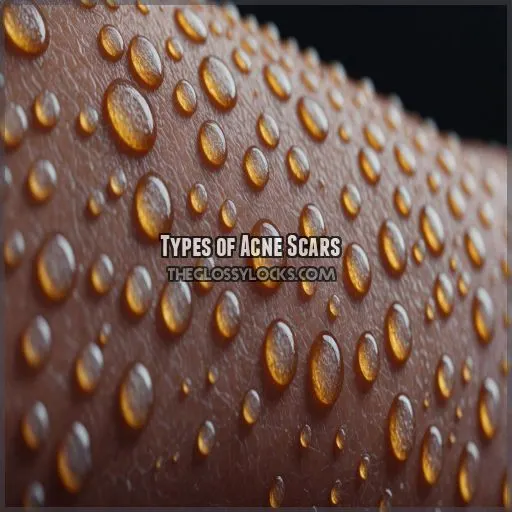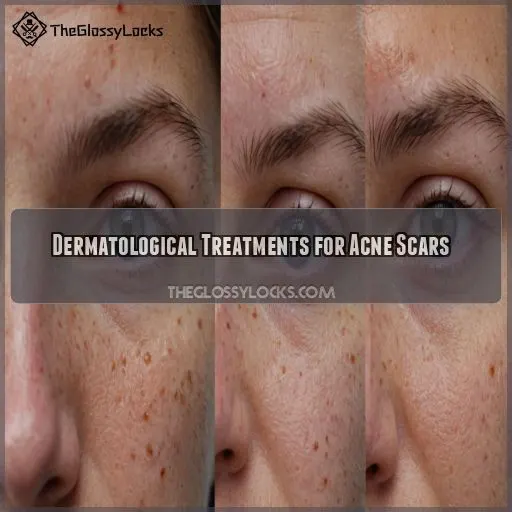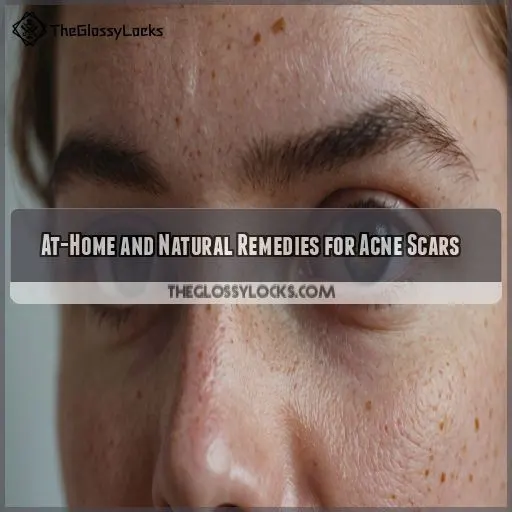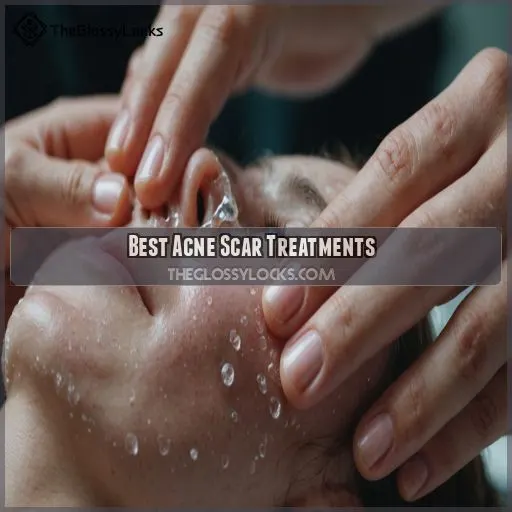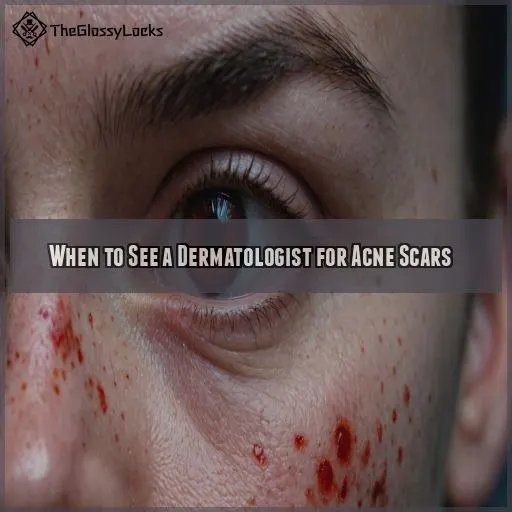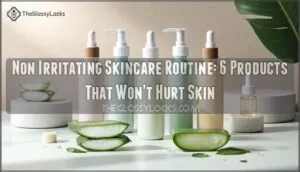This site is supported by our readers. We may earn a commission, at no cost to you, if you purchase through links.
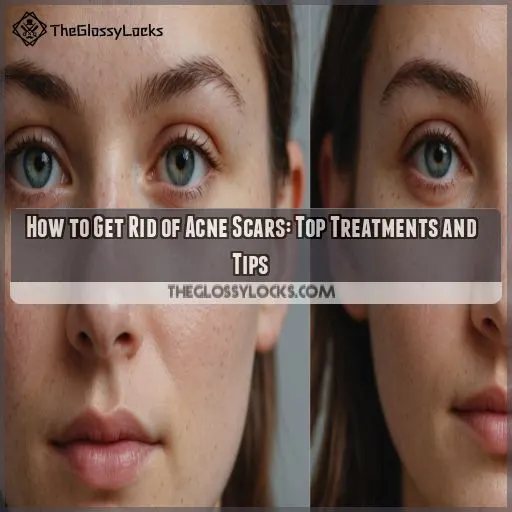 Getting rid of acne scars is like finally cleaning out that chaotic drawer—it’s about finding the right tools and sticking with it!
Getting rid of acne scars is like finally cleaning out that chaotic drawer—it’s about finding the right tools and sticking with it!
First, identify your scar type. Are they atrophic dips, raised bumps, or dark marks?
For stubborn scars, laser skin resurfacing and chemical peels work wonders.
Microneedling can rejuvenate your skin’s fabric.
For a homegrown approach, try soothing natural remedies like aloe vera or vitamin C, and don’t forget sunblock.
Your path to smoother skin depends on your unique blend of scar solutions—just like choosing toppings at a salad bar!
Discover more tips on achieving flawlessly clear skin by tackling blackheads.
Table Of Contents
- Key Takeaways
- Types of Acne Scars
- Dermatological Treatments for Acne Scars
- At-Home and Natural Remedies for Acne Scars
- Best Acne Scar Treatments
- When to See a Dermatologist for Acne Scars
- Frequently Asked Questions (FAQs)
- How do you make acne scars go away?
- Can I remove acne scars naturally?
- Are acne scars permanent?
- Does vitamin C help with acne scars?
- What lifestyle changes can help prevent acne scars?
- Are certain diets effective for minimizing acne scars?
- Can stress contribute to the formation of acne scars?
- How do I choose products safe for sensitive skin?
- What precautions should I take post-treatment for scarring?
- Conclusion
Key Takeaways
- Identify your scar type – whether they’re atrophic dips, raised bumps, or dark marks – so you can choose the right treatments, like laser resurfacing, chemical peels, or natural remedies.
- Be patient and consistent with your skincare routine. Clearing acne scars is like taming a messy drawer – it takes time and the right tools, but you’ll feel refreshed when it’s done.
- Don’t be afraid to see a dermatologist. They’re the skin care wizards who can develop a personalized plan to minimize your scars, whether that’s with laser treatments, fillers, or other professional procedures.
- Protect your skin from the sun and avoid picking at pimples – those habits can worsen scarring and make your skin renovation project a lot harder. Treat your complexion with TLC, and it will reward you with a glowing, scar-free canvas.
Types of Acne Scars
You’ve probably noticed that acne scars aren’t all the same; some are like tiny craters while others are raised bumps that just won’t budge. Understanding the types of scars—atrophic, hypertrophic, and those pesky post-inflammatory dark spots—can help you choose the best treatment, so you won’t need to Photoshop every selfie.
Atrophic Scars
Imagine your skin as a landscape, where atrophic scars create valleys with boxcar depressions, ice pick pits, and rolling hills. These depressed acne scars may feel like a thorn in your side, but fear not! Atrophic scar treatment options like laser therapy and chemical peels can smooth your skin’s terrain, while makeup cleverly camouflages any lingering imperfections.
Hypertrophic and Keloid Scars
While atrophic scars are about sunken impressions, hypertrophic and keloid scars rise like little mountains on your skin’s landscape. Think of hypertrophic scars as acne’s stubborn remnants. Keloids, however, go rogue, expanding beyond the initial breakout zone. Combat these pesky bumps with hypertrophic scar treatments, like silicone sheets or gentle scar massage techniques. You’ll bid farewell to unsightly bulges!
Post-inflammatory Hyperpigmentation
Alongside acne scars, post-inflammatory hyperpigmentation can also leave its mark. These darker patches of skin aren’t true scars, but rather a result of excess melanin production during the healing process. The good news? With proper sun protection and the right fade treatments, these discolored spots can gradually diminish over time.
- Look for products with alpha-hydroxy acids, retinoids, or azelaic acid to help fade dark spots.
- Avoid excessive sun exposure, as UV rays can worsen hyperpigmentation.
- Consider professional treatments like chemical peels or laser resurfacing for stubborn discoloration.
Causes of Acne Scars
To understand the causes of acne scars, it’s all about your skin’s collagen tango. Inflammatory acne, with its fiery nature, damages skin and collagen alike. Throw in genetics, and you get a lasting impact. During healing, collagen production can go haywire, leading to scars. Remember, picking acne is a highway to scar city!
Factors That Increase Scarring Risk
Six factors can make acne scars more likely to hang around.
Genetics, acne severity, or delayed treatment can lead to lingering reminders of those troublesome days.
Picking at your acne is a surefire way to invite scars and regrets!
Different skin types handle wounds uniquely, making ice pick scars or rolling atrophic scars more likely if inflammation isn’t managed promptly.
Dermatological Treatments for Acne Scars
If over-the-counter treatments aren’t cutting it, don’t worry – there are plenty of professional dermatological procedures that can help minimize the appearance of those pesky acne scars. From laser resurfacing to microneedling, your dermatologist has a toolbox full of effective treatments to get your skin looking its best.
Resurfacing Procedures
Imagine your skin’s top layer like a sticky note that’s seen better days. Resurfacing procedures, such as laser resurfacing and chemical peels, can peel away that worn layer, promoting rejuvenation. Microdermabrasion and dermabrasion smoothen and refresh the surface, offering clearer skin. It’s all about kickstarting a new beginning for your skin, just like a fresh start!
Microneedling
Microneedling is like giving your skin a motivational pep talk; it boosts collagen to smooth those pesky acne scars.
Unlike laser beams or punch grafting, this technique uses tiny needles to tackle imperfections.
Thinking of microneedling at home? Be cautious! While it’s great for wrinkles, watch for side effects.
Recovery time is short, so you’ll be back to glowing in no time!
Radiofrequency Skin Tightening
If you’re dealing with stubborn, deep acne scars like boxcar or icepick scars, radiofrequency skin tightening may be a game-changer. This treatment uses controlled heat energy to stimulate collagen production, effectively smoothing and lifting those pesky indentations. The best part? It’s relatively quick, with minimal downtime – just a few days of redness, tops. Sign me up!
- Targets deep, stubborn acne scars
- Stimulates collagen production for smoother skin
- Quick treatment with minimal downtime
- Can improve the appearance of boxcar and icepick scars
Subscision
If you’re tackling those pesky acne scars, subscision might just be your knight in shining armor. This procedure disrupts the fibrous bands under the skin, freeing the scar to heal smoother. It’s like untangling earphone cords—satisfying and effective! Compared to fillers, subscision offers longer results. Post-procedure, give skin time to recover and pamper it with care.
Injections for Raised Scars
If you have stubborn, raised acne scars, your dermatologist may recommend injectable treatments.
Steroid injections can help flatten and soften those pesky bumps, while fillers like Restylane or Juvederm can plump up depressed areas.
The cost varies, but the results can be quite impressive.
Just be aware of potential side effects like bruising or discoloration.
With the right approach, those raised scars can become a distant memory.
At-Home and Natural Remedies for Acne Scars
You don’t need a magic wand to tackle acne scars; some remedies might be lingering right in your bathroom cabinet. By using over-the-counter chemical peels and natural ingredients like salicylic acid and retinoids, you’ll be armed and ready to smooth those pesky scars and restore your skin’s natural glow. Learn more about salicylic acid.
Over-the-Counter Chemical Peels
Over-the-counter chemical peels can be a game-changer for tackling acne scars at home. Look for peels containing:
- Lactic acid to gently exfoliate and fade discoloration.
- Glycolic acid to smooth texture and minimize pitting.
- Citric acid to brighten and even out skin tone.
- Azelaic acid to target stubborn hyperpigmentation.
Start slow, follow directions, and always wear sunscreen after peeling for best results.
Ingredients to Look for in Peels
When looking for acne scar treatments at home, focus on peels with potent ingredients.
| Ingredient | Benefits |
|---|---|
| Alpha Hydroxy Acids |
Resurfaces skin like a shiny new floor.
Cleans pores, as effortlessly as a vacuum.
Boosts collagen, turns back time.
Natural Remedies for Acne Scars
If over-the-counter peels aren’t your thing, don’t worry – there are plenty of natural remedies right in your pantry that can help fade acne scars. Try DIY masks with ingredients like:
- Honey – a natural humectant that can hydrate and soothe skin.
- Aloe vera – soothes inflammation and promotes healing.
- Vitamin C – an antioxidant that can brighten and even out skin tone.
- Essential oils like tea tree or rosehip – packed with skin-nourishing properties.
Home Care Routine for Acne Scars
Look who’s back for more! Ready to tackle those pesky scars DIY style? Consider adding a gentle scar massage and some natural ingredients to your skincare routine, like bakuchiol for acne. This helps in preventing new scars and also heals old ones. Here’s a fun table for you:
| Routine Step | Mood Boost | Popular Choice |
|---|---|---|
| Cleanse | Refresh | Aloe Vera |
| Exfoliate | Invigorate | Baking Soda |
| Moisturize | Rejuvenate | Coconut Oil |
| Sunscreen | Protect | Zinc Oxide |
You’ve got this!
Best Acne Scar Treatments
When acne scars have overstayed their welcome, turning to the best treatments can be your clear-skin saviors! From laser resurfacing to fillers, these options help you say goodbye to those stubborn marks with a mix of science and a sprinkle of patience.
Laser Resurfacing
Laser resurfacing can feel like a miracle for acne scars—but it’s got quirks. It isn’t for everyone. Consider these when weighing the choice:
- Laser Risks: Redness, swelling, itching—oh my!
- Cost Comparison: It can hit wallets hard.
- Downtime: Skip work? Yes, please!
- Best Candidates: Specified by skin type.
Choose wisely and consult your skin savior!
Chemical Peels
Chemical peels, a nifty trick up your sleeve, can tackle acne scars by removing dead skin layers after microneedling. They enhance your skin’s appearance, offering various types for that specific touch. While peel at home kits are tempting, professional treatment provides better results. Keep in mind peel risks, recovery time, and potential peel costs. Remember, patience is key!
Punch Excision
Chemical peels can refresh your skin, but for stubborn pitted scars, punch excision is your best buddy. Think of it as a tiny cookie-cutter for scar removal. This procedure neatly extracts individual scars, allowing smoother skin to heal over.
- Punch excision addresses deep scars.
- Minor procedure with quick recovery.
- Ideal for stubborn depressions.
Subcision
Punch excision might’ve kicked your scars to the curb, but think about subcision as giving them a solid shove. The subcision procedure involves breaking fibrous tissue with a needle, letting scars float more freely. Unlike fillers, subcision focuses on long-lasting results. You’ll feel like a giddy scientist discovering subcision recovery; costs vary, but side effects are minimal!
Fillers and Autologous Fat Transfer
You’ve just explored subcision, but if that sounds like more than you bargained for, fillers and autologous fat transfer might tickle your fancy. Think of them as quick fixes in your toolbox. Here’s why:
- Filler types: From Restylane to Sculptra.
- Cost comparison: Varies greatly.
- Downtime: Minimal, thankfully.
- Risks, Results: Low risk for smoothness!
When to See a Dermatologist for Acne Scars
For most people, discoloration and scarring will fade with proper acne treatment and sun if your acne scars haven’t improved within a year, it’s time to consult a dermatologist – they can develop a personalized treatment plan to help minimize the appearance of your scars.
How to Know if You Need Professional Help
If you’re wondering if it’s time to see a dermatologist, consider the severity of your scars and available treatment options. Assess how your skin type responds to home remedies versus professional care skin care routine. Don’t wait for a magic wand! Compare treatment costs and benefits. Consulting a dermatologist can bring clarity.
| Scar Severity | Treatment Options | Skin Type |
|---|---|---|
| Mild | Home remedies, peels | Oily |
| Moderate | Microneedling, subcision | Combination |
| Severe | Laser, fillers | Sensitive |
Benefits of Early Intervention
Don’t wait to take action! Early treatment of acne scars offers a path to reduced severity, preventing scars from setting up camp permanently on your skin. Think of it as saving future you from costly procedures. You’ll enjoy improved confidence, all without needing a scavenger hunt to find the best solution. Act now, and your skin will thank you!
What to Expect From a Dermatologist Consultation
After deciding to tackle acne scars, you’ll kick things off with a dermatologist consultation.
This is like meeting the wise oracle of skin.
Discuss your consultation goals and explore treatment options that are right for you.
Expect a cost breakdown and aftercare advice.
Understand your doctor’s philosophy, because trusting them is half the battle.
It’ll be like charting a smooth course for a brighter complexion!
Frequently Asked Questions (FAQs)
How do you make acne scars go away?
Rome wasn’t built in a day," and neither will your skin. Tackle acne scars by consulting a dermatologist for professional treatments like lasers or microneedling. At-home remedies, like chemical peels, offer gradual improvement.
Can I remove acne scars naturally?
You can naturally reduce acne scars with home remedies like aloe vera, honey, and tea tree oil. These remedies work to soothe, moisturize, and reduce inflammation, helping your skin gradually heal and regain its smooth appearance (Source).
Are acne scars permanent?
Acne scars can feel like uninvited guests that overstay their welcome. While some are permanent, many can fade or even vanish with the right treatments—like laser therapy or microneedling—giving your skin a fresh, clean slate (Source).
Does vitamin C help with acne scars?
Think of vitamin C as a helping hand for your skin. Just like sunlight brightens your day, vitamin C can brighten acne scars by boosting collagen and reducing pigmentation. Give it a whirl; your skin might thank you!
What lifestyle changes can help prevent acne scars?
Prevent acne scars by not picking pimples, managing stress, and eating foods rich in omega-3 fatty acids. These lifestyle changes reduce inflammation and promote healing. Say goodbye to stressful breakouts and embrace clearer, happier skin! (Source).
Are certain diets effective for minimizing acne scars?
Certain diets can help minimize acne scars. Eating omega-3 rich foods like salmon, antioxidant-rich greens, and low-glycemic foods like legumes won’t turn you into a supermodel overnight, but they can boost your skin’s healing process .
Can stress contribute to the formation of acne scars?
You bet stress can worsen acne scars! When you’re stressed, your body pumps out hormones that inflame skin and disrupt collagen production – the building blocks of healthy, scar-free skin. Luckily, managing stress through exercise, meditation, and a balanced diet can help minimize scarring.
How do I choose products safe for sensitive skin?
To pick products safe for sensitive skin, start by dodging allergens like fragrances. Look for labels stating "hypoallergenic" and "noncomedogenic." Test new items on a small skin area first—your skin’s like a detective solving its own mystery.
What precautions should I take post-treatment for scarring?
After treatment, about 82% of people see improvements but protect your skin like it’s a delicate treasure. Avoid sun, use gentle skincare products, stay hydrated, and give your skin time to heal—it’s your body’s renovation project!
Conclusion
Clearing acne scars is like planting a garden; you’ll need patience and the right tools.
Not every garden blooms overnight, so stick to your regimen.
Whether opting for home solutions or professional help, remember, smoother skin is an attainable goal.
Check out treatments like laser resurfacing, microneedling, and natural remedies to figure out how to get rid of acne scars effectively.
Don’t let scars define you; there’s beauty in nurturing what lies beneath.
Embrace your journey to clear skin!

